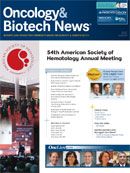Publication
Article
Individualized Approach to Treatment for the Elderly Ovarian Cancer Patient
Author(s):
Stuart Lichtman, MD, and William Tew, MD, from Memorial Sloan-Kettering Cancer Center, discuss personalizing treatment for elderly patients with ovarian cancer.
Stuart Lichtman, MD
William Tew, MD
Memorial Sloan-Kettering Cancer Center
The population of older adults (aged >65 years) is growing rapidly, and will account for 20% of the population by 2030. Unfortunately, oncologists are ill-prepared for this demographic shift, as older adults have been underrepresented in cancer clinical trials that have set the standard of care.
Ovarian cancer has an age-related increase in incidence and a twofold increased risk of death in women older than 65 years of age.1 There have been various theories proposed to account for this survival disparity, including more aggressive cancer with advanced age; inherent resistance to chemotherapy; individual patient factors, such as multiple comorbidities; and physician and healthcare biases toward the elderly, which lead to inadequate surgery, less-than-optimal chemotherapy, and poor enrollment in clinical trials.
We retrospectively reviewed the outcome and toxicity differences seen in 620 patients (aged 70 years) enrolled in Gynecologic Oncology Group (GOG) study 182, a large phase III trial studying triplet-chemotherapy regimens for patients with newly diagnosed ovarian cancer. We found that older patients had poorer performance status, lower completion rates of chemotherapy, and increased toxicities, particularly grade 3+ neutropenia and grade 2+ neuropathy. Older women had significantly shorter overall survival (37 vs 45 months; P <.001), consistent across all regimens and adjusted for major prognostic factors.2
A French study illustrated the potential for a geriatric assessment (GA) to predict chemotherapy toxicity and overall survival in elderly patients with advanced ovarian cancer.3 Three factors were independent predictors of significant toxicity: symptoms of depression at baseline, dependence, and ECOG performance status <2.3
A cancer-specific GA was developed through the Cancer and Aging Research Group. The GA included validated measures for functional status, comorbid medical conditions, cognition, psychological state, social functioning, social support, and nutrition (Table). This GA is quick and mostly self-administered. In a large 500-patient study, we developed a predictive model and risk factors for grade 3-5 chemotherapy toxicity that included: (1) age 73; (2) cancer type (gastrointestinal and urologic cancer); (3) standard chemotherapy dosing; (4) poly-chemotherapy regimens; (5) falls in past 6 months; (6) assistance with instrumental activities of daily living (IADL); and (7) decreased social activity.4
Table. Domains and Measures in the
Geriatric Assessment (GA) Questionnaire4
Domain
Measure
Functional Status
Activities of Daily Living
Instrumental Activities of Daily Living
Karnofsky Self-Reported Performance Rating Scale
Karnofsky Physician-Rated Performance Rating Scale
Number of Falls in Last 6 Months
Comorbidity
Comorbidity Physical Health Section
Psychological State
Hospital Anxiety and Depression Scale
Social Activity
MOS Social Activity Survey
Social Support
MOS Social Support Survey: Emotional/Information and Tangible Subscales
Nutrition
Body Mass IndexBody Mass Index
Percent Unintentional Weight Loss in Last 6 Months
MOS indicates Medical Outcomes Study.
Figure. Geriatric Assessment (GA) During Upfront Treatment for Ovarian Cancer*
MOS indicates Medical Outcomes Study. *Upfront treatment takes approximately 6 months to complete.
We are currently conducting a prospective trial to determine the benefits of this GA for women aged >65 years with newly diagnosed advanced ovarian cancer. The study is supported through a National Comprehensive Cancer Network (NCCN) award. Patients will undergo a GA at four time points during their chemotherapy and debulking surgery (Figure). Toxicity and outcomes will be monitored. The goal is to determine whether geriatric variables can predict toxicity. In addition, half of the patients will receive a weekly telephone call from a geriatric nurse who will reinforce medication compliance, offer psychosocial support, and facilitate appropriate referrals. Quality of life, use of care, and satisfaction parameters will be compared to those patients receiving standard oncology care alone. Ultimately, these results will aid the NCCN-Senior Adult Panel with the development of guidelines for the integration of a GA and nurse telephone interventions into an oncology practice.
References
- Tew WP, Lichtman SM. Ovarian cancer in older women. Semin Oncol. 2008;35(6):582-589.
- Tew WP, Java J, Chi D, et al. Treatment outcomes for older women with advanced ovarian cancer: results from a phase III clinical trial (GOG182). J Clin Oncol. 2010;28:15s (suppl; abstr 5030).
- Trédan O, Geay JF, Touzet S, et al. Carboplatin/ cyclophosphamide or carboplatin/paclitaxel in elderly patients with advanced ovarian cancer? Analysis of two consecutive trials from the Groupe d’Investigateurs Nationaux pour l’Etude des Cancers Ovariens. Ann Oncol. 2007;18(2):256-262.
- Hurria A, Togawa K, Mohile SG, et al. Predicting chemotherapy toxicity in older adults with cancer: a prospective multicenter study. J Clin Oncol. 2011;29(25):3457-3465.










